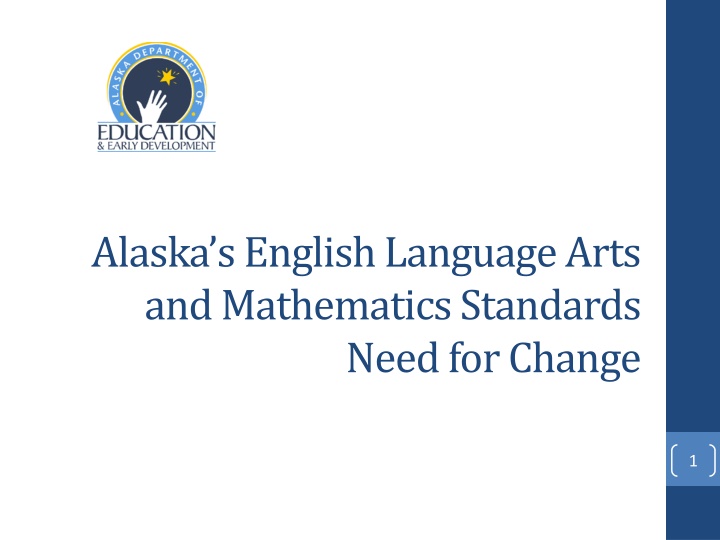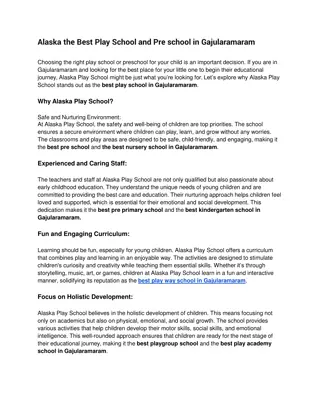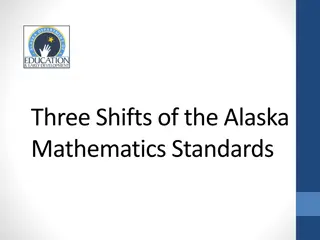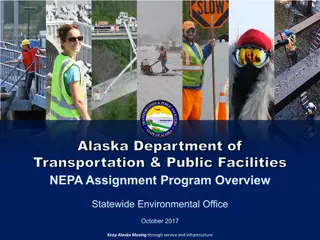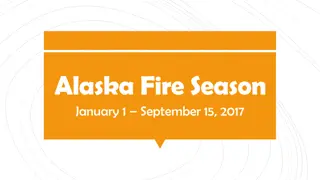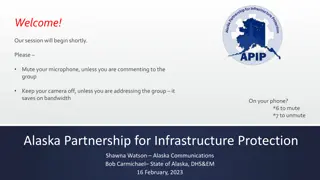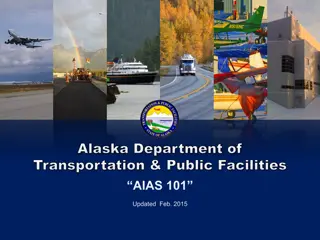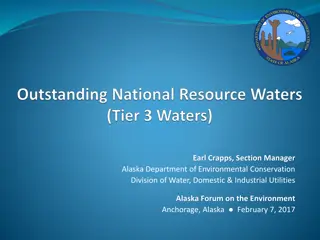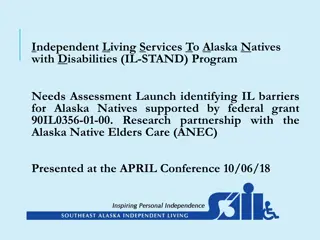Alaska's Educational Standards Evolution
Alaska's English Language Arts and Mathematics standards have evolved over the years, from age-span standards in the 1990s to Grade Level Expectations (GLEs) in 2004 and an expansion to include kindergarten through second grade in 2006. Educators have reviewed and compared the GLEs to national standards, revealing areas for improvement. Data from the National Assessment of Educational Progress (NAEP) further indicate a need for higher learning standards to enhance students' competitiveness at national and international levels.
Download Presentation

Please find below an Image/Link to download the presentation.
The content on the website is provided AS IS for your information and personal use only. It may not be sold, licensed, or shared on other websites without obtaining consent from the author.If you encounter any issues during the download, it is possible that the publisher has removed the file from their server.
You are allowed to download the files provided on this website for personal or commercial use, subject to the condition that they are used lawfully. All files are the property of their respective owners.
The content on the website is provided AS IS for your information and personal use only. It may not be sold, licensed, or shared on other websites without obtaining consent from the author.
E N D
Presentation Transcript
Alaskas English Language Arts and Mathematics Standards Need for Change 1
History of Standards 1990s: Alaska standards in reading, writing, and mathematics were developed by age spans 2004: Grade Level Expectations (GLEs) in reading, writing, and mathematics were developed to further define standards at each grade level (grades 3 10) 2006: Grade Level Expectations were expanded to include kindergarten through second grade 2
What do we know about Alaska s Grade Level Expectations? 3
Alaskan educators reviewed and compared the Alaskas Grade Level Expectations (GLEs) and other common national standards. We know: 1. 2. 3. 4. 5. the GLEs are over six years old. the GLEs do not extend beyond grade 10. the GLEs are broad and open to teacher interpretation. the GLEs are lower in rigor than other standards. the GLEs are a blueprint for assessment. 4
What evidence suggests Alaskas students need a higher learning standard? 5
National Competitiveness The National Assessment of Educational Progress (NAEP) is the common measurement of student achievement NAEP was created in 1969; the No Child Left Behind Act (NCLB) mandated state participation in NAEP reading and math every other year Alaska has NAEP data for 2003, 2005, 2007, 2009, and 2011 for grades 4 and 8 in reading and math 6
International Competitiveness The Program for International Student Assessment (PISA) is an international study which began in the year 2000. PISA aims to evaluate education systems worldwide by testing the skills and knowledge of 15-year-old students in participating countries/economies. Since the year 2000 over 70 countries and economies have participated in PISA. 11
What makes the Alaska English Language Arts Standards different? What tools will they provide so Alaska graduates can be nationally and globally competitive? 15
English Language Arts address kindergarten - 12 grade. increase text complexity within the Reading Standards. connect Reading and Writing Standards. designate Writing and Language Standards. provide speaking and listening criteria. 16
What makes the Alaska Mathematics Standards different? What tools will they provide so Alaska graduates can be nationally and globally competitive? 17
Mathematics Standards address kindergarten grade 12. focus critical areas identified in grades K-8. provide coherence progression of topics across grades allowing for higher level math earlier. establish increased rigor - increased through use of the Standards for Mathematical Practice. present by conceptual categories or domains instead of courses or grade levels in high school. 18
Tools for Alaskas Graduates 1. Increased text complexity will bridge the gap between high school and college/work readiness. Connections between writing and reading will strengthen research skills. Speaking and listening standards promote collaboration and clear communication. Rigorous math content will have application to real world problems. In-depth analysis of mathematical and logical arguments will increase critical thinking skills. 2. 3. 4. 5. 19
Relevancy The new standards align with the uniqueness of Alaska. Combined with the Cultural Standards and local educators, relevant learning experiences will continue. Same relevancy as the GLEs Allow for relevancy at a greater level The proposed standards establish a strong foundation of knowledge and skills all students need for success after graduation. It is up to schools and teachers to decide how to put the standards into practice and incorporate other state standards, including the cultural standards. 20
Contacts Karen Melin, Language Arts Content Specialist karen.melin@alaska.gov, 907-465-6536 Deborah Riddle, Mathematics Content Specialist deborah.riddle@alaska.gov, 907-465-8703 Bjorn Wolter, Science Content Specialist bjorn.wolter@alaska.gov, 907-465-6542 Elizabeth Davis, Assessment Administrator elizabeth.davis@alaska.gov, 907-465-8431
